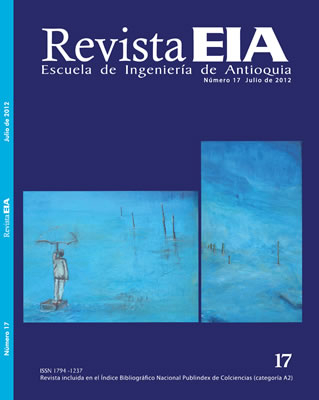EVALUATION OF HMA CRACKING RESISTANCE AS A FUNCTION OF LABORATORY AGING BASED ON THE DIRECT-TENSION TEST (EVALUACIÓN DE LA RESISTENCIA AL AGRIETAMIENTO DE MEZCLAS ASFÁLTICAS EN CALIENTE EN FUNCIÓN DE SU ENVEJECIMIENTO A PARTIR DEL ENSAYO DE TENSIÓN DIREC
EVALUATION OF HMA CRACKING RESISTANCE AS A FUNCTION OF LABORATORY AGING BASED ON THE DIRECT-TENSION TEST (EVALUACIÓN DE LA RESISTENCIA AL AGRIETAMIENTO DE MEZCLAS ASFÁLTICAS EN CALIENTE EN FUNCIÓN DE SU ENVEJECIMIENTO A PARTIR DEL ENSAYO DE TENSIÓN DIREC


Esta obra está bajo una licencia internacional Creative Commons Atribución-NoComercial-SinDerivadas 4.0.
Declaración del copyright
Los autores ceden en exclusiva a la Universidad EIA, con facultad de cesión a terceros, todos los derechos de explotación que deriven de los trabajos que sean aceptados para su publicación en la Revista EIA, así como en cualquier producto derivados de la misma y, en particular, los de reproducción, distribución, comunicación pública (incluida la puesta a disposición interactiva) y transformación (incluidas la adaptación, la modificación y, en su caso, la traducción), para todas las modalidades de explotación (a título enunciativo y no limitativo: en formato papel, electrónico, on-line, soporte informático o audiovisual, así como en cualquier otro formato, incluso con finalidad promocional o publicitaria y/o para la realización de productos derivados), para un ámbito territorial mundial y para toda la duración legal de los derechos prevista en el vigente texto difundido de la Ley de Propiedad Intelectual. Esta cesión la realizarán los autores sin derecho a ningún tipo de remuneración o indemnización.
La autorización conferida a la Revista EIA estará vigente a partir de la fecha en que se incluye en el volumen y número respectivo en el Sistema Open Journal Systems de la Revista EIA, así como en las diferentes bases e índices de datos en que se encuentra indexada la publicación.
Todos los contenidos de la Revista EIA, están publicados bajo la Licencia Creative Commons Atribución-NoComercial-NoDerivativa 4.0 Internacional
Mostrar biografía de los autores
Hot mix asphalt (HMA) is a heterogeneous composite material of asphalt-binder, aggregates, air voids, and other additives including lime, fibers, etc., predominantly used for pavement construction. With time, the HMA mix ages, which leads to changes in the material properties and response behavior. This paper documents a laboratory study that was conducted to evaluate the suitability of the direct-tension (DT) test to assess the effects of asphalt-binder aging on the HMA mix fracture properties and cracking-resistance potential. Two dense-graded HMA mixes were subjected to different laboratory aging exposure conditions and then tested with the DT test. From this test, the HMA mix fracture response was characterized in terms of the tensile strength, tensile strain at peak failure load, stiffness, and fracture energy. Overall, the results indicated that asphalt-binder aging has a detrimental effect on the fracture response and cracking-resistance of HMA mixes, which can be captured based on the DT test. Therefore, the asphalt-binder aging needs to be considered and properly accounted for during the material design and analysis stages of HMA mixes. However, research with more HMA mixes and correlation with field data is strongly recommended to validate the laboratory findings reported in this paper.
Resumen: La mezcla asfáltica en caliente (MAC) es un material compuesto, heterogéneo, integrado por cemento asfáltico (o asfalto), agregados, vacíos y otros aditivos incluyendo cal, fibras, etc., usado predominantemente para la construcción de pavimentos. A lo largo del tiempo, la MAC sufre envejecimiento, lo cual conlleva cambios en las propiedades del material y en su respuesta. Este artículo documenta un estudio de laboratorio llevado a cabo para evaluar la posibilidad de emplear el ensayo de tensión directa (TD) para determinar los efectos del envejecimiento del asfalto sobre las propiedades de fractura y resistencia al agrietamiento de MAC. Dos MAC de gradación densa fueron sometidas a diferentes condiciones de envejecimiento en laboratorio y luego sometidas al ensayo de TD. A partir de este ensayo, el comportamiento ante fractura se caracterizó en términos de la resistencia a tensión, deformación unitaria de tensión a la carga de falla, rigidez y energía de fractura. En general, los resultados indicaron que el envejecimiento por oxidación del asfalto tiene un efecto negativo sobre la respuesta ante fractura y la resistencia al agrietamiento de la MAC, el cual puede ser captado por medio del ensayo de TD. Por lo tanto, el envejecimiento del asfalto debe ser considerado y cuantificado en forma adecuada durante el diseño y análisis de la MAC. Sin embargo, se recomienda adelantar investigación adicional con otras mezclas y correlacionar resultados con datos de campo para validar la información de laboratorio reportada en este artículo.
Visitas del artículo 262 | Visitas PDF 157
